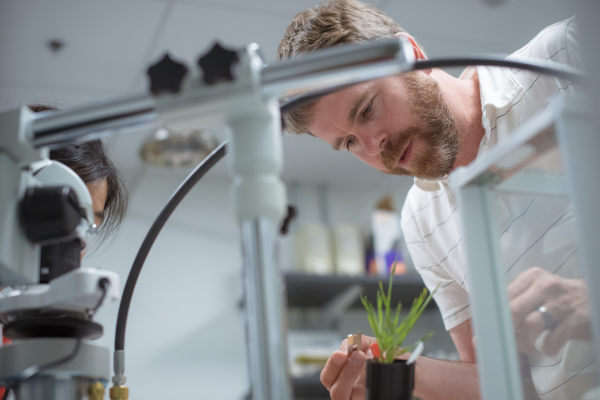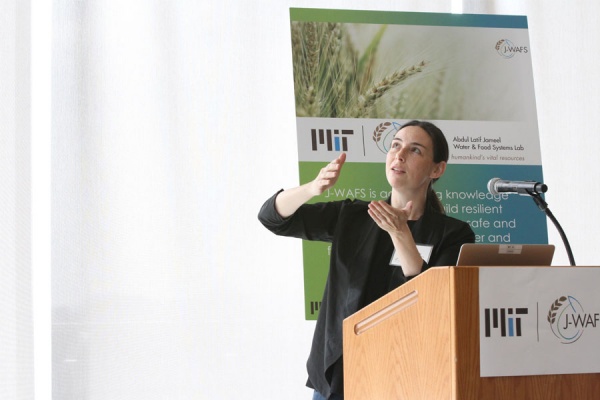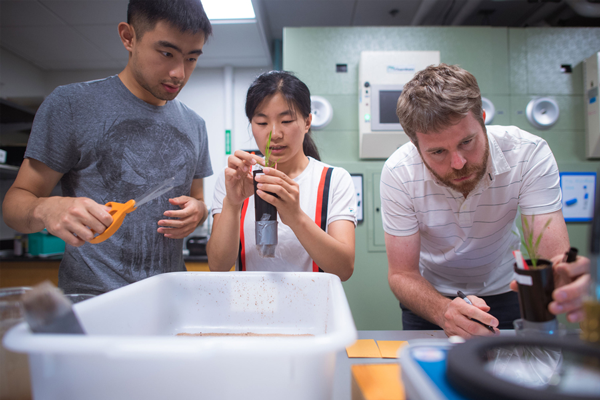Our Research Novel systems biology tools for improving crop tolerance to abiotic stressors

CEE Graduate student Jie Yun measures rates of photosynthesis on plants experiencing soil drying stress in the Des Marais Lab Plant Growth Facility. Photo credit: Gretchen Ertl
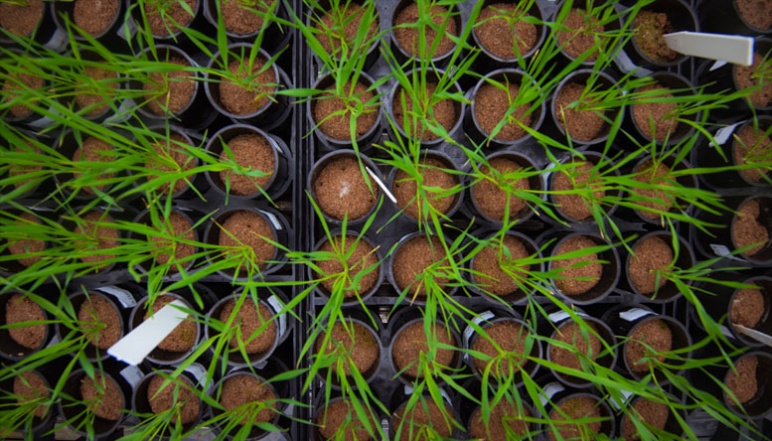
The Des Marais Lab uses the model grass species Brachypodium distachyon to understand plant-environment interaction. Here, replicate plants are receiving two different levels of soil water availability to study genetic differences in response to drying. Photo credit: Gretchen Ertl
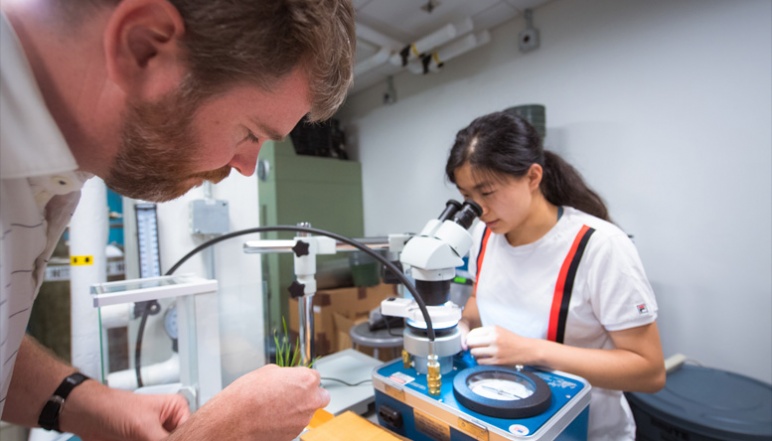
Professor David Des Marais harvests leaf tissue for metabolic analysis while graduate student Jie Yun measures the water potential of leaves which have experienced a mild soil drying. These data will be integrated with measures of gene expression to generate a systems-level understanding of plant response to drying stress. Photo credit: Gretchen Ertl
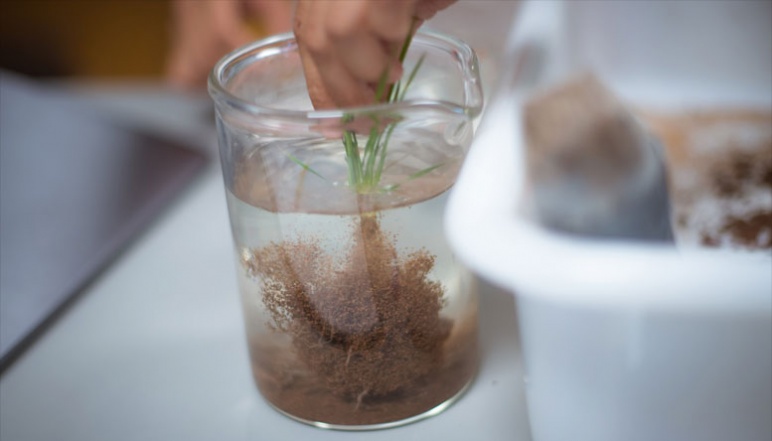
Roots play a critical role in plant response to soil drying. Here, roots of are washed clean of soil prior to analysis. Photo credit: Gretchen Ertl
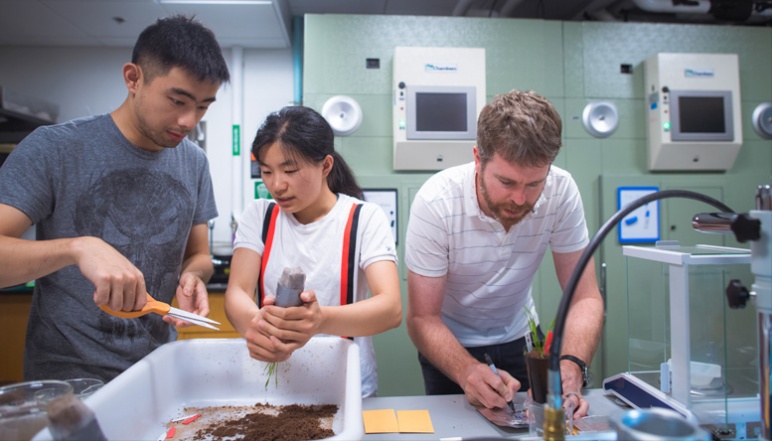
Graduate students Haoran Cai and Jie Yun, and Professor David Des Marais harvest plants during the soil drying experiment. This experiment is part of a JWAFS-funded project to identify genes and features of gene regulatory networks which mediate plant response to environmental stress. Photo credit: Gretchen Ertl
Principal Investigators
David L. Des Marais
- Cecil & Ida Green Career Development Professor
- Associate Professor of Civil and Environmental Engineering
- Department of Civil and Environmental Engineering
Caroline Uhler
- Henry L. and Grace Doherty Associate Professor
- Department of Electrical Engineering and Computer Science
- Institute for Data, Systems and Society
Challenge:
What cellular mechanisms regulate plant response to environmental stress? Can we identify key genes or pathways that might be manipulated to increase agricultural productivity?
Research Strategy
- Develop a new computational approach to infer the functional relationships among thousands of genes which respond to environmental stress
- Generate a large gene expression dataset contrasting environmental response in two natural varieties of a target grass species
- Analyze the gene expression dataset using newly developed analytical tools to predict how a plant’s genome might be modified to improve environmental resilience
Project description
Soil water availability is a major determinant of agricultural productivity worldwide; yet improving plant performance under soil drying and other abiotic stressors has proven to be a persistent challenge for conventional and biotechnological breeding. The challenge can be explained, in part, by the complex and myriad ways that plants respond to these environmental cues. From a practical breeding perspective, this complexity is manifested in strong correlation between stress response pathways and more fundamental aspects of plant growth and survival. Therefore breeding to improve performance under limiting environments invariably reduces crop yield under ideal conditions.
Plant molecular biologists have identified many of the cellular signaling and response pathways involved in abiotic stress response, but they remain largely ignorant of how these mechanisms interact with one another, when interactions at the molecular level very likely drive the trait correlations that confound breeding efforts. Therefore, a more mechanistic understanding of molecular and physiological interactions will allow for better design of stress-tolerant plants to improve yield to feed a growing population under increasingly unpredictable climactic conditions.
The research team of this project is developing new analytical tools to understand the structure and dynamics of gene regulatory networks (GRN). GRNs are the proximate mechanism through which plants perceive changes in the environment, transduce the signal of these perceptions between cells and tissues, and coordinate tissue and whole-plant responses to survive under stressful conditions.
Of particular interest for agricultural improvement is identifying and manipulating gene pathways that are expressed in environmentally dependent ways. For example, in response to soil drying a plant might coordinately activate a set of genes that together increase the efficiency with which water is used during growth. Current methods to detect this type of coordinated change in the activities of genes involve post-hoc analysis, i.e. compare the gene regulatory relationships in benign conditions with those that occur in stressful conditions, and compare the two. A more fruitful and powerful approach would be to integrate data from both conditions during the estimation of regulatory relationships, and then query the sets of parameters describing those relationships in order to better understand their functional basis on each condition.
Principal investigators Des Marais and Uhler are addressing this problem by developing novel tools of GRN estimation and comparison by using a new dataset generated in a model grass species, Brachypodium distachyon. This collaboration unites the extensive expertise in plant-environment interaction and sustainable agriculture that Des Marais possesses with that of Prof. Uhler, who is a leader in statistical approaches to studying networks.
Outcomes
- Developed an algorithm capable of identifying differences in highly complex causal networks simultaneously rather than one at a time
- Conducted a large experiment to assess natural genetic diversity in response to soil drying using the model grass species Brachypodium distachyon
- Findings showed a strong signature of altered photosynthetic carbon reduction and the redirection of carbohydrates away from storage and towards metabolism during soil drying. Genetic diversity of this response was found among the studied plant varieties
- Performed RNA sequencing on plant samples. The resulting analysis of the gene regulatory architecture of drought response identified co-expression relationships that vary as a function of both genotype and environment
Publications
Direct estimation of differences in causal graphs
Yuhao Wang, Chandler Squires, Anastasiya Belyaeva, and Caroline Uhler, Advances in Neural Information Processing Systems (NeurIPS 2018), 2018
News
Additional Details
Impact Areas
- Food
- Climate & Sustainability
Research Themes
- Sustainability & Adaptation
- Transforming Food Systems
- Modeling & Data Analytics
Year Funded
- 2018
Grant Type
- Seed Grant
Status
- Completed



